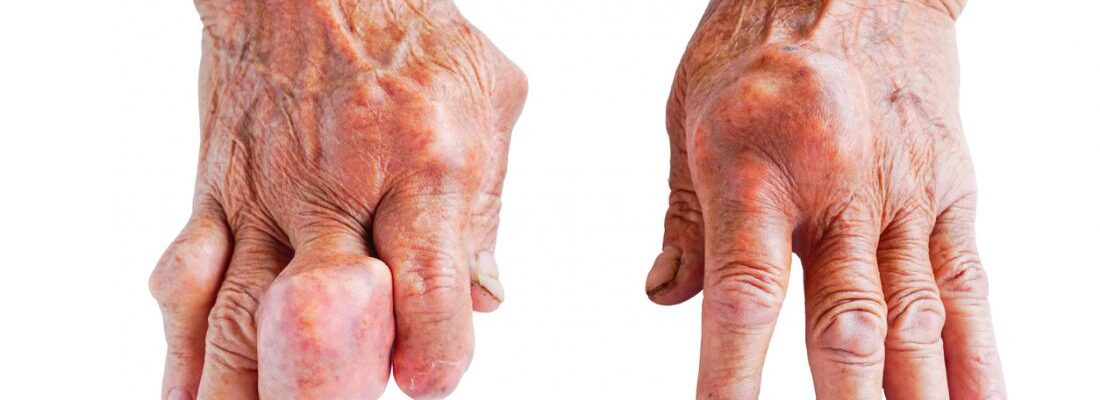Summary
Gout is a condition marked by painful inflammation in specific joints, particularly in the fingers, toes, and other areas of the hands and feet. The term “gout” comes from the Latin gutta, meaning “drop of liquid,” based on an early belief that gout was caused by fluid buildup in the body.
The condition occurs when excess uric acid accumulates in the blood, forming sharp crystals in the joints. Typically, the kidneys filter out uric acid, but certain factors can disrupt this process, causing uric acid to crystallize within the joints. This leads to severe pain, swelling, and stiffness, often limiting movement in the affected areas.
Gout is manageable through medications that alleviate pain and reduce uric acid levels, along with lifestyle changes, such as dietary adjustments, to lower the likelihood and frequency of future flare-ups.
Table of Contents
Symptoms of Gout

Gout attacks often strike suddenly, usually at night. The primary symptoms of gout include:
- Intense joint pain. Gout most commonly affects the big toe, though it can also impact other joints, such as the knees, fingers, elbows, hands, and ankles. The pain is typically most severe within the first four to twelve hours of the attack.
- Lingering discomfort. After the sharp pain subsides, a lingering discomfort or sensitivity in the affected joints can persist for days to weeks. Subsequent gout attacks may last longer and affect more joints.
- Swelling and redness. Affected joints become extremely swollen, tender, red, and may feel warm to the touch as inflammation progresses.
- Limited mobility. As gout worsens, it becomes increasingly challenging to move the affected joints normally, especially during severe or repeated attacks.
These symptoms can significantly impact daily life and mobility. Early treatment can help alleviate symptoms, prevent complications, and reduce the likelihood of recurrent attacks.
Types of Gout
Gout presents in several stages or types, each with unique characteristics and severity:
- Asymptomatic hyperuricemia. In this stage, high levels of uric acid are present in the blood, but no symptoms are evident. While this stage may not require treatment, the accumulation of uric acid crystals in the joints over time can cause damage, increasing the risk of future gout attacks.
- Acute gout. In this type, accumulated urate crystals trigger intense inflammation and severe pain in the affected joint(s). Acute gout episodes can last between three to ten days and may be triggered by factors such as excessive alcohol consumption, certain medications, stress, or even cold weather.
- Intercritical gout. This stage occurs between acute gout attacks, where there may be no symptoms. However, urate crystals continue to accumulate in the body, which can eventually lead to more frequent and severe gout flare-ups if left unmanaged.
- Chronic tophaceous gout. This is the most severe form of gout, marked by the formation of hard urate deposits, or tophi, in the joints and surrounding tissue. Chronic tophaceous gout can lead to permanent joint damage, loss of mobility, and, in severe cases, kidney impairment due to the long-term buildup of urate crystals.
Each stage of gout has different implications for treatment and management. Early diagnosis and lifestyle changes can help manage uric acid levels and reduce the risk of progressing to more severe stages.
Diagnostic Procedures for Gout
Diagnosing gout involves a series of examinations and tests to confirm the presence of urate crystals, evaluate uric acid levels, and rule out other joint conditions. Common diagnostic procedures include:
- Physical examination and symptom review. A doctor will examine the affected joints, checking for redness, swelling, and tenderness. They will also review the patient’s medical history and symptoms to assess whether they align with typical gout attacks.
- Joint fluid test. This is the most definitive test for gout. A small sample of fluid is drawn from the affected joint with a needle and examined under a microscope to detect the presence of urate crystals, which confirms a gout diagnosis.
- Blood test. A blood test can measure uric acid levels to help identify hyperuricemia (high uric acid in the blood). However, high uric acid alone does not confirm gout, as some people with high uric acid do not develop gout, and some with gout may have normal levels during a flare-up.
- Imaging tests (X-ray, ultrasound, or CT scan). Imaging can help detect urate crystals and damage in the joints, especially in advanced or chronic gout. Ultrasound is particularly effective for spotting urate deposits, while dual-energy CT scans can reveal crystal buildup in joints when needed.
These diagnostic steps help confirm gout and distinguish it from other joint-related conditions like rheumatoid arthritis or infection. A clear diagnosis allows for more effective treatment and management of symptoms to prevent further complications.
Complications of Untreated Gout
When gout is left untreated, it can lead to serious complications that affect joint health, kidney function, and overall well-being. The following are some of the key complications associated with untreated gout:
- Tophi formation. Untreated gout can cause the buildup of hard urate crystal deposits, called tophi, in the joints and surrounding tissues. These lumps can develop on the fingers, toes, elbows, and other joints, leading to discomfort, deformity, and limited mobility. Tophi can also become inflamed and painful, worsening the condition.
- Chronic joint damage. Persistent urate crystal deposits can damage cartilage and joint structures, leading to chronic pain, reduced flexibility, and permanent joint deformities. Over time, this can make everyday movements difficult and severely limit quality of life.
- Kidney stones. Excess uric acid can accumulate in the kidneys, forming kidney stones that can block urinary pathways, causing severe pain and discomfort. Recurrent kidney stones can lead to kidney damage over time and increase the risk of infections.
- Kidney disease. Long-term high levels of uric acid can lead to uric acid buildup in the kidneys, contributing to chronic kidney disease or even kidney failure. This condition, known as urate nephropathy, may develop if high uric acid levels are not managed.
- Increased risk of cardiovascular disease. Studies show that individuals with gout are at higher risk of cardiovascular diseases, such as hypertension, heart attack, and stroke. The inflammatory processes and high uric acid levels associated with gout may contribute to this increased risk.
Proper management and treatment of gout can help prevent these complications, protecting joint health, kidney function, and overall cardiovascular wellness. Early diagnosis and lifestyle adjustments, combined with medication if necessary, are essential to minimizing the long-term effects of gout.
Causes of Gout

The primary cause of gout is the buildup of uric acid in the blood, which can lead to crystal formation in the joints. Several factors contribute to this uric acid buildup:
- Lifestyle factors. Approximately 12% of gout cases are linked to diet and drink choices. Excessive consumption of meat, seafood, alcoholic beverages, and sugary drinks containing fructose can raise uric acid levels. Among these, alcohol, particularly beer, has the strongest link to increased risk of gout, as it interferes with the body’s ability to remove uric acid.
- Genetics. Genetics play a role in gout susceptibility. Specific genes, such as SLC2A9, SLC22A12, and ABCG2, have been identified as contributors to the development of gout, as they affect how the body processes and eliminates uric acid. Those with a family history of gout are at a higher risk of developing the condition.
- Medical conditions. Certain health conditions can increase the risk of gout, including insulin resistance, hypertension, high triglycerides, abdominal obesity, and metabolic syndrome. Other medical issues like organ transplants, anemia, chronic kidney disease, and lead poisoning can also elevate uric acid levels, contributing to gout.
- Medications. Some medications are known to raise uric acid levels or interfere with its excretion. These include diuretics, aspirin, niacin, ACE inhibitors, beta blockers, and immunosuppressive drugs. Patients on these medications may be at an increased risk for gout and may need monitoring to manage uric acid levels.
These factors can interact to elevate uric acid levels, leading to gout flare-ups and the formation of painful urate crystals in the joints. Recognizing and managing these risk factors can help in the prevention and treatment of gout.
Prevention of Gout

Diet and drink choices play a major role in managing and preventing gout. The following steps can help reduce the risk of gout attacks:
- Maintain a healthy weight. Monitoring weight is essential, as excess body weight can increase uric acid levels. Regular exercise is recommended, but avoid rapid weight loss methods like fasting or extreme calorie restriction, as these can temporarily raise uric acid levels in the blood.
- Drink plenty of fluids. Staying hydrated helps lower uric acid levels by promoting kidney function. However, it’s best to avoid sugary drinks, especially those sweetened with fructose, as these can increase uric acid and trigger gout attacks.
- Limit intake of meat, poultry, and fish. Certain types of meat and seafood are high in purines, which raise uric acid levels. You can still consume these foods in moderation, but it’s wise to keep portion sizes small and be mindful of frequency.
- Limit alcohol consumption. Alcohol, particularly beer, is strongly associated with gout, especially in men. While it’s possible to enjoy alcohol in moderation, consult your doctor for personalized advice, as even small amounts may trigger gout symptoms in some individuals.
- Opt for low-fat dairy products. Low-fat dairy items, such as skim milk or low-fat yogurt, not only help with weight management but have also been shown to reduce uric acid levels, potentially lowering the risk of gout flare-ups.
By adopting these dietary habits and maintaining a healthy lifestyle, individuals can better manage uric acid levels and reduce the likelihood of developing gout or experiencing recurrent attacks.
Risk Factors for Gout

Anyone can be affected by gout, especially those who do not take preventive measures. However, some risk factors for gout, such as age and gender, are beyond one’s control. While risk reduction can’t completely eliminate the possibility of developing gout, preventive steps can help lower the frequency and severity of attacks.
The following are key risk factors for gout:
- Obesity. One of the main risk factors for gout is obesity. Excess body weight has been proven to increase uric acid levels in the blood, as confirmed by numerous studies. Managing weight through a balanced diet and regular exercise can help reduce this risk.
- Excessive alcohol consumption. Those who consume large amounts of alcohol, particularly beer, are at a higher risk for gout. Alcohol can significantly raise blood uric acid levels, as shown in research, making it a significant factor in developing gout.
- Other contributing factors. Additional risk factors include:
- Hypertension. High blood pressure has been associated with an increased risk of gout.
- Lack of physical activity. A sedentary lifestyle can contribute to weight gain and metabolic issues, raising gout risk.
- High LDL (bad) cholesterol and low HDL (good) cholesterol. Unhealthy cholesterol levels may increase susceptibility to gout and other metabolic disorders.
- Elevated triglycerides. High triglyceride levels in the blood are associated with metabolic issues, including a higher risk of gout.
- Insulin resistance. Insulin resistance, often associated with metabolic syndrome, increases uric acid levels and is a known risk factor for gout.
Understanding and managing these risk factors through lifestyle adjustments and, when necessary, medical support, can be crucial in preventing or managing gout effectively.
Gout FAQs
Here are answers to some frequently asked questions about gout, helping you understand this common condition and its management.
- What is gout?
Gout is a form of arthritis caused by high levels of uric acid in the blood. Excess uric acid forms sharp crystals that accumulate in joints, causing intense pain, inflammation, and swelling, particularly in the big toe, though it can affect other joints as well. - What causes gout?
Gout is caused by an accumulation of uric acid in the blood. This may occur due to overproduction of uric acid, decreased ability of the kidneys to eliminate it, or dietary and lifestyle factors. Certain medical conditions, medications, and genetic factors can also increase gout risk. - What are the symptoms of a gout attack?
A gout attack often starts suddenly, typically at night, with symptoms like intense joint pain, swelling, redness, and warmth. The pain is usually most severe in the first 4 to 12 hours and can last for days or even weeks if untreated. - Who is at risk for gout?
Risk factors for gout include obesity, excessive alcohol consumption (especially beer), high blood pressure, certain medications, and a family history of the condition. Men and postmenopausal women are also more likely to develop gout. - How is gout diagnosed?
Doctors diagnose gout through physical examination, joint fluid analysis to detect uric acid crystals, blood tests to measure uric acid levels, and sometimes imaging tests to check for crystal deposits in the joints. - Can gout be cured?
There is no cure for gout, but it can be managed with medications to lower uric acid levels and reduce inflammation. Lifestyle changes, such as diet adjustments and weight management, also play an essential role in preventing gout attacks. - What foods should be avoided with gout?
High-purine foods, like red meat, shellfish, organ meats, and alcohol (particularly beer), can raise uric acid levels. Limiting sugary drinks, especially those with fructose, is also recommended as they can increase uric acid production. - Is gout hereditary?
Genetics can play a role in gout susceptibility. People with a family history of gout may have a higher likelihood of developing the condition due to inherited traits that affect uric acid processing. - How is gout treated?
Treatment includes medications like NSAIDs for pain relief, corticosteroids, or colchicine for inflammation, and drugs like allopurinol or febuxostat to lower uric acid levels. Diet and lifestyle changes are also essential for managing symptoms and preventing attacks. - Can gout lead to other health complications?
Yes, untreated gout can cause chronic joint damage, kidney stones, and increased risk of kidney disease. Gout is also associated with a higher risk of cardiovascular diseases, including hypertension and heart disease.


